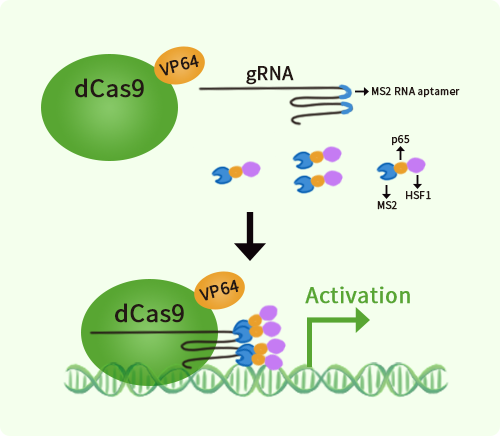Human TXNRD3 activation kit by CRISPRa
CAT#: GA114428
TXNRD3 CRISPRa kit - CRISPR gene activation of human thioredoxin reductase 3
Find the corresponding CRISPRi Inhibitor Kit
USD 1,657.00
2 Weeks*
Specifications
| Product Data | |
| Format | 3 gRNAs (5ug each), 1 scramble ctrl (10ug) and 1 enhancer vector (10ug) |
| Symbol | TXNRD3 |
| Locus ID | 114112 |
| Kit Components | GA114428G1, TXNRD3 gRNA vector 1 in pCas-Guide-GFP-CRISPRa GA114428G2, TXNRD3 gRNA vector 2 in pCas-Guide-GFP-CRISPRa GA114428G3, TXNRD3 gRNA vector 3 in pCas-Guide-GFP-CRISPRa 1 CRISPRa-Enhancer vector, SKU GE100056 1 CRISPRa scramble vector, SKU GE100077 |
| Disclaimer | These products are manufactured and supplied by OriGene under license from ERS. The kit is designed based on the best knowledge of CRISPRa SAM technology. The efficiency of the activation can be affected by many factors, including nucleosome occupancy status, chromatin structure and the gene expression level of the target, etc. |
| Reference Data | |
| RefSeq | NM_001173513, NM_052883 |
| UniProt ID | Q86VQ6 |
| Synonyms | TGR; TR2; TRXR3 |
| Summary | The protein encoded by this gene belongs to the pyridine nucleotide-disulfide oxidoreductase family, and is a member of the thioredoxin (Trx) system. Three thioredoxin reductase (TrxR) isozymes are found in mammals. TrxRs are selenocysteine-containing flavoenzymes, which reduce thioredoxins, as well as other substrates, and play a key role in redox homoeostasis. This gene encodes the third TrxR, which unlike the other two isozymes, contains an additional N-terminal glutaredoxin (Grx) domain, and shows highest expression in testis. The Grx domain allows this isozyme to participate in both Trx and glutathione systems. It functions as a homodimer containing FAD, and selenocysteine (Sec) at the active site. Sec is encoded by UGA codon that normally signals translation termination. The 3' UTRs of selenoprotein mRNAs contain a conserved stem-loop structure, the Sec insertion sequence (SECIS) element, which is necessary for the recognition of UGA as a Sec codon rather than as a stop signal. Alternatively spliced transcript variants have been found for this gene. Experimental evidence suggests the use of a non-AUG (CUG) codon as a translation initiation codon (PMID:20018845). [provided by RefSeq, Aug 2017] |
Documents
| Product Manuals |
| FAQs |
| SDS |
Resources
Other Versions
| SKU | Description | Size | Price |
|---|---|---|---|
| KN430340 | TXNRD3 - KN2.0, Human gene knockout kit via CRISPR, non-homology mediated. |
USD 1,657.00 |
{0} Product Review(s)
Be the first one to submit a review






























































































































































































































































 Germany
Germany
 Japan
Japan
 United Kingdom
United Kingdom
 China
China
